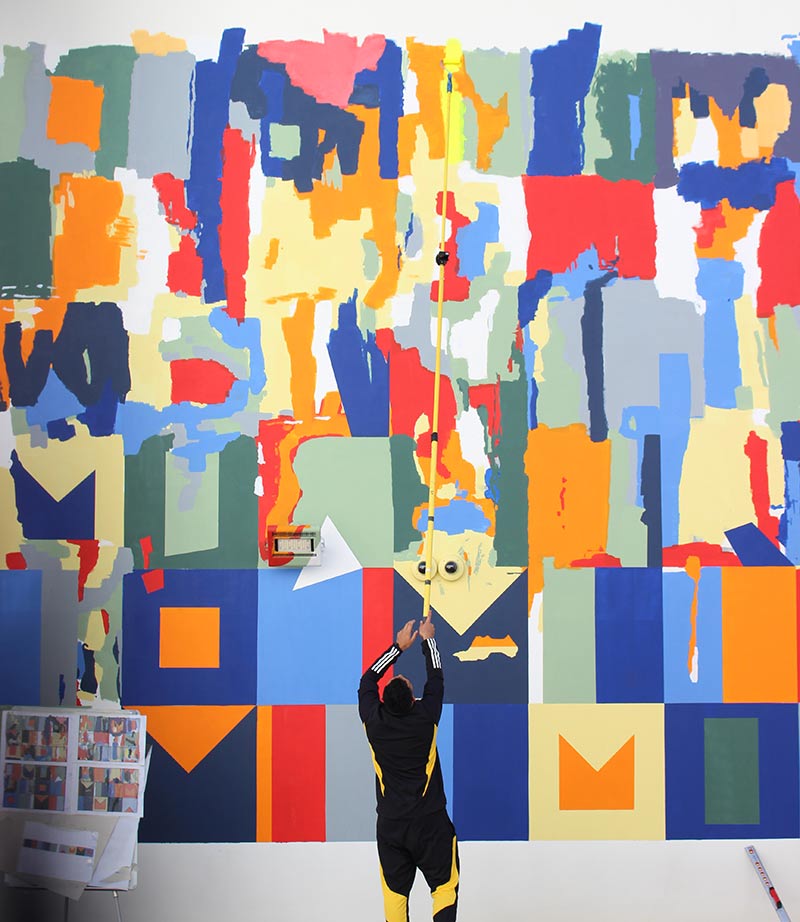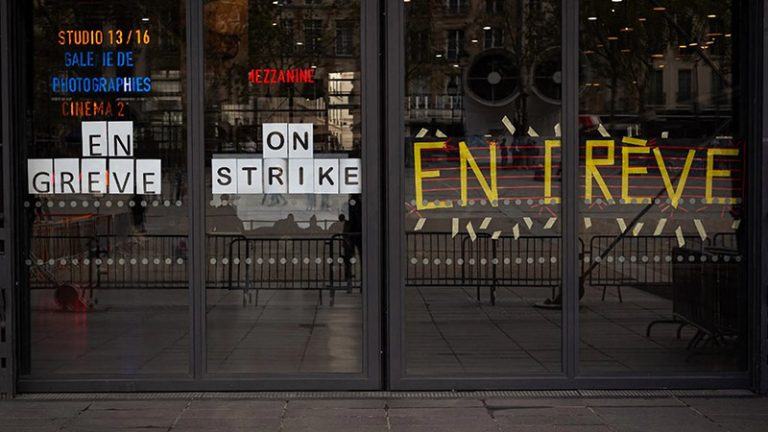Marseilles. Once past the security devices which control entries and exits from the Baumettes 2 (B2) penitentiary center, we arrive in a courtyard which seems to occupy the heart of it, as far as we can judge in this maze that is the Marseille remand center. On one of its walls, an 8 x 6.50 m fresco climbs towards the sky. Squares of color decorated with geometric patterns, at its base, deconstruct as the eye rises until they form looser flat areas, with an assumed disorder.
Supported by the interministerial “Culture and Justice” system following a call for projects, the work was produced in October 2023 by ten inmates under the direction of Germain Ipin and Elsa Mingot. He is an urban artist and stands on the disruptive and contextual side of this movement. She is the founder of the company La Conflagration, and this is far from being her first intervention in a prison environment. In 2021, she led the “Sonde 2.0.1” project in Fleury-Mérogis (Essonne), which brought together inmates and researchers to send a message to extraterrestrials using a balloon inflated with helium. It was she who convinced Germain Ipin to produce the 7th variation of “Was I Really?” at Les Baumettes. “. Born seven years ago, this long-term participatory project portrays Victor Vasarely as the father of urban art and reinterprets his work through workshops involving all kinds of participants. The fresco which adorns the courtyard of the remand center is thus inspired by the “Plastic Alphabet” of this major figure in optical art, and takes up some of the 26 shapes which compose it. She also signs Ipin’s first intervention in prison.
8 working sessions
On this rainy morning in December 2023, however, it is as a regular that he walks through the doors that lead to a small room. Elsa Mingot and Raphaël Julien, cultural coordinator of Spip (prison integration and probation service) of Bouches-du-Rhône, accompany him for a review meeting with the prisoners who worked from June 21 to October 10 at birth of the fresco.
Only three of them are there. Jonathan, the youngest, is 20 years old. Mike, the oldest, is past his thirties, but it is Yassin who stands there, with a smile on his lips, “veteran” : he is the only one in the assembly to have followed all eight workshops. In Baumettes, turnover is permanent. Since the end of the project, one of the participants has been released. Another is caught up in his work as an “auxi” (auxiliary) – a real Holy Grail in prison where he has to “canteen” [gagner de l’argent] to improve the ordinary. Three detainees preferred to stay in their cells or were not notified in time. Information, we are told, does not always circulate well in Baumettes where there is a glaring shortage of staff. Moreover, the review session was almost canceled that very morning, due to a lack of supervisors. According to Jonathan, the problem has been growing in recent months, and affects both the “comfort” of the prison and the activities and services offered. The hairdresser, for example, no longer comes.
As for the fresco, however, the young man does not hide his enthusiasm: “I see squares everywhere!” he laughs. My only regret is that it only lasted a week. » Yassin is of the same opinion, and willingly recounts the stages of the project: “We first chose a palette of ten colors from a color chart, based on those of the prison: blue for the guards, red for the auxis, gray for the Gepsa [agents d’accueil], etc. » On Post-its, the inmates then compose a word using Vasarely’s alphabet. Then they randomly draw 8 characters which will constitute the basis of the fresco. ““INASSMUT” is out, says Ipin. Or the anagram of “TSUNAMIS”. »
This word coined by chance suits the bias of “Was I Really?” », who wants to reintroduce emotion, accident and randomness into art, and offer “a counterpoint to the linearity of B2’s architecture”, as indicated on the fresco label. It also reflects the very specific conditions of its realization. Once its model was validated by the prison administration and by the inmates (they revised the first version which they considered too unstructured), it was indeed necessary to deal with innumerable constraints. “The chosen area was very sensitive, because it was busy,” explains Ipin. Exit ladders and scaffolding that could inspire escape projects: painters have to make do with poles and rollers. In this enterprise, resourcefulness, common in urban art, was undoubtedly an asset. Moreover, the artist notes that many graffiti artists intervene in prison.
A meeting between two universes
It was also necessary to mobilize a supervisor for a whole week. It was François, a retired reservist, who supervised the execution of the fresco, constantly interrupted by the comings and goings. “It was a small event, says Raphaël Julien. The project aroused a lot of curiosity and questions. » For the detainees, it was also a moment of visibility: “People talked with us, we felt important,” Mike explains.
However, despite an opening and a program broadcast on Radio Roquette (La Ciotat), the fresco received little response outside of Les Baumettes. In addition to the difficulties of accessing the site, the distribution of images taken in prison is closely monitored by the prison administration, a fortiori since the “Koh-Lanta affair”. In 2022, a video filmed in Fresnes (Val-de-Marne) sparked controversy, [le président des Républicains] Éric Ciotti insisted on this occasion that prisons were not ” camp “.
“Even if their impact is difficult to gauge, creations in a prison environment provide the opportunity for two very different worlds to meet, objects Elsa Mingot. Everyone is moving: the external workers who discover this world and the inmates. I regularly have phone calls when they leave prison, sometimes years later. This makes me say that it left its mark on some people. » Many prisoners request this type of project and must write a cover letter to participate. “Often, there are many more registrations than places, reports Elsa Mingot. Inmates are selected based on their background, sentences incurred and their release date. » In addition to offering a valuable escape from the cell, participation in a cultural project is recorded in the personal prison monitoring files. “It can influence a decision, for example a reduced sentence,” explains Elsa Mingot.
On the side of the participants, the action in a prison environment also has the merit of undoing the stereotypes conveyed by American series and films. “My many prejudices about this hitherto unknown universe have been shattered,” thus affirms Ipin on his Instagram account. Moreover, he is preparing a new project with Elsa Mingot at Arles prison…







